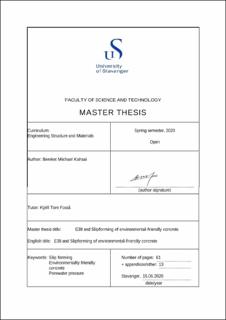| dc.description.abstract | Slipforming is a construction method that has been used in many years for production of concrete structures and it is mainly suited for tall structures such as towers, bridge columns, silos, and offshore platforms with simple geometry. However, unlike fixed formwork, the friction occurs between the formwork and the concrete surface during the process of slipforming, can cause lifting crack and other surface damage in the concrete if the friction is high.
The objective is to determine how the pore water pressure and frictional force between the slipform panel and environmentally friendly concrete develop, when the amount of clinker in the cement replaced by amount of fly ash. This process can help to limit CO2 emission into the atmosphere and minimizes environmental pollution. In addition, how the surface damage affected by the change also studied during the process of slipform.
The research comprises of two main parts: A review of relevant literature study and a laboratory testing program.
In the literature part, a theoretical study to understand the phenomena that affects the pore water pressure and the friction at the interface between the building-up concrete and the sliding panel is briefly described. In addition, the basic theory and principles of the slip form rig and properties of a fresh and hardened concrete is briefly explained.
A practical experimental test program was carried out in the concrete laboratory at the University of Stavanger. A total of 7-8 concrete mixes was planned to be tested in the sliding rig. Unfortunately, only 4 concrete mixes given from E39 Sulafjorden were carried out due to the corona virus lock-down of the laboratory at University of Stavanger.
In the experiment a cement with a combination of different amount of clinker and fly ash used to investigate how the friction and porewater pressure affected in slipforming process. Four mixes, two with 0.35 w/b ratio (mix-3 and mix-5) and the other two with 0.30 w/b ratio (mix-4 and mix-6) was used. Portland-fly ash (Anleggsement FA) that contains 85% clinker and 15% fly ash was used to prepare the concrete mix-3 and mix-4 and in the other two mixes a 20% clinker was replaced by fly ash.
The data from the experiments plotted in a graph to compare the evolution of different parameters that affect the slipforming process between the concrete mixes with same w/b ratio and different amount of clinker and fly ash. the focus was done on the trend in decreasing rate of the pore water pressure, which is the main objective, and found to be satisfactory in most cases according to the theory study. But the properties of fresh concrete mixes showed a reasonable difference from the original data obtained from E39 Sulafjorden. For instance, the data for slump measurements exhibits a relevant difference from that of given data. As a result, the workability of the concrete was not as intended (self-compacted concrete). A vibrator was used during casting of the concrete in the slip form rig.
The rate of decreasing of pore water pressure is higher in the concrete mix with normal Anleggsement FA and lower rate of decreasing of pore water pressure in the concrete mix with 20% clinker replacement with fly ash. The lifting force is maximum when the pore water pressure is at its minimum value. The pore water pressure decreases at the early stage of casting and starts to increase after a while and decreases until it comes to rise sharply at a constant rate then disappears at the final stage. These observations can be related to the lecture study that the early stage decreasing is because of the settlement in the fresh concrete. And after a while (during the elastic phase), the pore water pressure starts to decrease faster as an effect of the chemical shrinkage that occurs because of the cement reaction. And the final disappearance can be related to the break-through process.
The development of the temperature and surface damage also carefully studied. From the result it is clearly shown that the rate of the development of temperature is higher in the concrete mix with Anleggsement FA and the higher w/b ratio has higher rate of development of temperature.
According to the lecture study, the risk for surface damage is higher in case of high friction. But in this experiment, there was not any surface damage seen. The surface of the hardened concrete was smooth and sound. | en_US |
